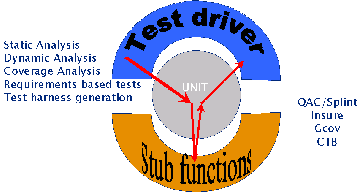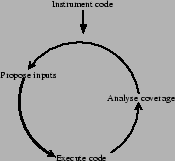




Next: Tutorial
Up: TUTTI Reference
Previous: TUTTI Reference
Contents
Index
Subsections
What is TUTTI
TUTTI offers a unified test framework using various test tools. It
introduces a test infrastructure for an organization producing
software. Features of TUTTI are:
- User friendliness by means of a simple, uniform and intuitive user interface to (existing) test tools.
- Tests are well organized
- Tests can easily be automated
- Legible test results can easily be generated
- Easy to integrate with Configuration Management and a
development environment
Ideas behind TUTTI
A unit test focuses on testing a piece of software. In our context, a
unit is
a library or a daemon process that is part of our software. Unit testing is a
verification method that is used to get confidence about the quality of the
software. There are five ideas that play a key role in unit testing.
- The aim of any testing activity is finding defects in software.
- When no defects were found after thorough testing, we have confidence in
the quality of the software.
- Testing is not always the best verification method. This depends on the risks and the effort that would be needed to do enough testing.
- Quality of software may still be poor, despite it's proved functional
behavior. Non functional behavior of the software is also relevant.
- Both white-box and black-box tests are important for unit
testing.
- The earlier a defect has been found, the less costs are needed in order
to fix it [6].
Developing unit tests
Figure 6.1:
A unit is often tested in a simulated environment (stubs). A driver is needed to invoke the functions defined in the unit and to check the outcome.
 |
Several test techniques are relevant when developing unit tests.
Firstly, the maintainability, correctness and robustness of
the software must be assured by static analysis. Static analysis is a test technique that enables
a tester/programmer to analyze thew software in a static way. This
means, none of the code need to be exercised. A great benefit of the
static analysis is that the code need not be complete in order to be
tested and about 40% of possible software defects can be located this
way[7]. Therefore, a static analysis must be carried out as
the first test.
Of course, it is also important to exercise the code by
so-called dynamic testing (i.e. testing
dynamic behavior of the code by executing it). The design of a dynamic
test is the most important step for this part. The design is based upon
two approaches:
- Black-box test design.
Test cases are derived from the requirements
by using formal test design techniques such as boundary value
analysis, cause effect graphing or equivalence class partitioning[5]. For example, when the user
can input the lifetime of a certain hash value between 0 and 1000 ms, this boils
down to:
- Try to find out an element for input representing a type of input
class (-10, 10, 2000 ).
- Try to find the inputs that focus on the boundaries of the
requirement ( 0, 1000, 1001).
Figure 6.2:
Selecting inputs for a life time of a hash value using
equivalence-class-partitioning and boundary value analysis design techniques.
 |
- White-box test design.
Test
cases are derived from the software itself using a reverse-engineering
approach. Often coverage analysis is used
for this purpose. This means that it is analyzed how many (and which) of
the statements in the software are actually exercised by the test. Using
the results of this coverage analysis, the inputs are adapted an the
code is executed with the new inputs. This iterative process results
in a set of inputs that will cause enough code to be executed by the
test. After generating test inputs this way, checks are inserted in the
code that verify the supposed effect or result of that specific input.
Figure 6.3:
Design of a unit test using a white-box approach. Test inputs are
derived iteratively from the outcome of the coverage
analysis.
 |
Common problems with unit testing
Test tools used in a development environment have at least two
drawbacks. A major drawback often experienced is the lack of clearness of
the resulting output. Often, a user of a certain test tool finds himself
wasting time by examining output from a test tool that is difficult
to comprehend. Many times, test output is blurred by irrelevant (non)
information or problems are issued which are doubtful or for which their
is no consensus.
An example of this is the analysis of a program file test.c with lclint or splint as a static
analysis tool.
#include <stdio.h>
int main ( void )
{
int p;
printf("hello %i.n", p );
return 0;
}
The output of splint is directed to the stderr device:
test.c: (in function main)
test.c:6:26: Variable p used before definition
An rvalue is used that may not be initialized to a value on some execution
path. (Use -usedef to inhibit warning)
test.c:6:5: Called procedure printf may access file system state, but globals
list does not include globals fileSystem
A called function uses internal state, but the globals list for the function
being checked does not include internalState (Use -internalglobs to inhibit
warning)
test.c:6:5: Undocumented modification of file system state possible from call
to printf: printf("hello %i\n", p)
report undocumented file system modifications (applies to unspecified
functions if modnomods is set) (Use -modfilesys to inhibit warning)
Finished checking --- 3 code warnings
As shown by this example, a developer can have a hard time analyzing
this output. This is output from only 8 lines of code. Only one of these
lines (the second line) contains probably useful information.
Different tools, need different options. Often tools are just difficult
to use. Also the most easiest way of using a particular tool is not
the best way. For these reasons, it is recommended to create wrappers
around the test tools that provide a uniform interface to the tools and
to the outcome of the test tools. Together with legible output, it must
be clear whether the test failed or was successful without having to
read more than two lines of output.
Bubble provides an interface for the test tools insure, QAC, splint,
gcov and other tools. The user interface is similar to an ordinary
compiler.
By doing so, the Makefile need not be adapted to support
any of these tools. The tools that either instrument or analyze
the source code can be invoked as a compiler wrapper with the name
 toolname
toolname _compiler. The output of the analysis or execution of the
instrumented code is analyzed with a tool named
_compiler. The output of the analysis or execution of the
instrumented code is analyzed with a tool named  toolname
toolname _scan. The
next example, shows how the previous file is analyzed with splint and
QAC.
_scan. The
next example, shows how the previous file is analyzed with splint and
QAC.
qac_compiler -c -g -I /usr/local/include test.c
This results in a file test.qac that is analyzed by the tool
qac_scan:
qac_scan
..
Next, we analyze the code with splint:
splint_compiler -c -g -I /usr/local/include test.c
This results in a file test.lint which can be analyzed with the tool
splintscan:
splint_scan
...
The analysis tools issue their results in compiler error format by
default. HTML code is generated by specifying -html as an option. E.g.:
qac_scan -html





Next: Tutorial
Up: TUTTI Reference
Previous: TUTTI Reference
Contents
Index
2004-05-28



